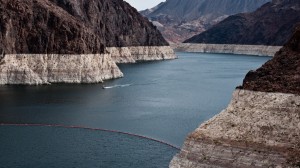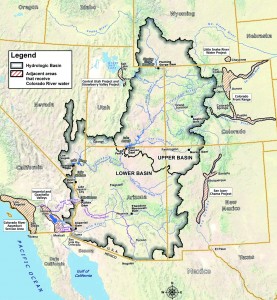24 July 2014
WASHINGTON, D.C. — A new study finds more than 75 percent of the water loss in the drought-stricken Colorado River Basin since late 2004 came from underground resources. The extent of groundwater loss may pose a greater threat to the water supply of the western United States than previously thought.
This study is the first to quantify the amount that groundwater contributes to the water needs of western states. According to the U.S. Bureau of Reclamation, the federal water management agency, the basin has been suffering from prolonged, severe drought since 2000 and has experienced the driest 14-year period in the last hundred years. The study has been accepted for publication in Geophysical Research Letters, a journal of the American Geophysical Union, which posted the manuscript online today.

The Colorado River Basin lost nearly 53 million acre feet of freshwater over the past nine years, according to a new study based on data from NASA’s GRACE mission. This is almost double the volume of the nation’s largest reservoir, Nevada’s Lake Mead (pictured). Credit: U.S. Bureau of Reclamation
The research team, led by NASA and University of California, Irvine, scientists, used data from NASA’s Gravity Recovery and Climate Experiment (GRACE) satellite mission to track changes in the mass of the Colorado River Basin, which are related to changes in water amount on and below the surface. Monthly measurements of the change in water mass from December 2004 to November 2013 revealed the basin lost nearly 53 million acre feet (65 cubic kilometers) of freshwater, almost double the volume of the nation’s largest reservoir, Nevada’s Lake Mead. More than three-quarters of the total — about 41 million acre feet (50 cubic kilometers) — was from groundwater.
“We don’t know exactly how much groundwater we have left, so we don’t know when we’re going to run out,” said Stephanie Castle, a water resources specialist at the University of California, Irvine, and the study’s lead author. “This is a lot of water to lose. We thought that the picture could be pretty bad, but this was shocking.”
Water above ground in the basin’s rivers and lakes is managed by the U.S. Bureau of Reclamation, and its losses are documented. Pumping from underground aquifers is regulated by individual states and is often not well documented.
“There’s only one way to put together a very large-area study like this, and that is with satellites,” said senior author Jay Famiglietti, senior water cycle scientist at NASA’s Jet Propulsion Laboratory (JPL) in Pasadena, California, on leave from UC Irvine, where he is an Earth system science professor. “There’s just not enough information available from well data to put together a consistent, basin-wide picture.”
Famiglietti said GRACE is like having a giant scale in the sky. Within a given region, the change in mass due to rising or falling water reserves influences the strength of the local gravitational attraction. By periodically measuring gravity regionally, GRACE reveals how much a region’s water storage changes over time.
The Colorado River is the only major river in the southwestern United States. Its basin supplies water to about 40 million people in seven states, as well as irrigating roughly four million acres of farmland.

The Colorado River Basin (black outline) supplies water to about 40 million people in seven states. Major cities outside the basin (red shading) also use water from the Colorado River. Credit: U.S. Bureau of Reclamation
“The Colorado River Basin is the water lifeline of the western United States,” said Famiglietti. “With Lake Mead at its lowest level ever, we wanted to explore whether the basin, like most other regions around the world, was relying on groundwater to make up for the limited surface-water supply. We found a surprisingly high and long-term reliance on groundwater to bridge the gap between supply and demand.”
Famiglietti noted that the rapid depletion rate will compound the problem of short supply by leading to further declines in streamflow in the Colorado River.
“Combined with declining snowpack and population growth, this will likely threaten the long-term ability of the basin to meet its water allocation commitments to the seven basin states and to Mexico,” Famiglietti said.
Coauthors included other scientists from NASA’s Goddard Space Flight Center, Greenbelt, Maryland, and the National Center for Atmospheric Research, Boulder, Colorado. The research was funded by NASA and the University of California.
GRACE is a joint mission with the German Aerospace Center and the German Research Center for Geosciences, in partnership with the University of Texas at Austin. JPL developed the GRACE spacecraft and manages the mission for NASA’s Science Mission Directorate, Washington.
For more information on NASA’s GRACE satellite mission, see: http://www.nasa.gov/grace and http://www.csr.utexas.edu/grace.
###
The American Geophysical Union is dedicated to advancing the Earth and space sciences for the benefit of humanity through its scholarly publications, conferences, and outreach programs. AGU is a not-for-profit, professional, scientific organization representing more than 62,000 members in 144 countries. Join our conversation on Facebook, Twitter, YouTube, and other social media channels.
NASA monitors Earth’s vital signs from land, air and space with a fleet of satellites and ambitious airborne and ground-based observation campaigns. NASA develops new ways to observe and study Earth’s interconnected natural systems with long-term data records and computer analysis tools to better see how our planet is changing. The agency shares this unique knowledge with the global community and works with institutions in the United States and around the world that contribute to understanding and protecting our home planet. To learn more about NASA’s Earth science activities in 2014, visit: http://www.nasa.gov/earthrightnow.
Notes for Journalists
Journalists and public information officers (PIOs) of educational and scientific institutions who have registered with AGU can download a PDF copy of this accepted article by clicking on this link: http://onlinelibrary.wiley.com/doi/10.1002/2014GL061055/abstract
Or, you may order a copy of the final paper by emailing your request to Peter Weiss at [email protected]. Please provide your name, the name of your publication, and your phone number.
Neither the paper nor this press release is under embargo.
“Groundwater Depletion During Drought Threatens Future Water Security of the Colorado River Basin”
Authors:
Stephanie L. Castle: UC Center for Hydrologic Modeling, University of California, Irvine, CA, USA; and Department of Earth System Science, University of California, Irvine, CA, USA;
Brian F. Thomas and John T. Reager: UC Center for Hydrologic Modeling, University of California, Irvine, CA, USA; Department of Earth System Science, University of California, Irvine, CA, USA; and NASA Jet Propulsion Laboratory, California Institute of Technology, Pasadena, CA, USA.
Matthew Rodell: Hydrological Sciences Laboratory, NASA Goddard Space Flight Center, Greenbelt, MD, USA;
Sean C. Swenson: Climate and Global Dynamics Division, National Center for Atmospheric Research, Boulder, CO, USA;
James S. Famiglietti: UC Center for Hydrologic Modeling, University of California, Irvine, CA, USA; Department of Earth System Science, University of California, Irvine, CA, USA; and NASA Jet Propulsion Laboratory, California Institute of Technology, Pasadena, CA, USA.
Contact information for the authors:
James Famiglietti: +1 (818) 354-0052, [email protected]
Stephanie Castle: +1 (949) 436-0730, [email protected]
Peter Weiss
+1 (202) 777-7507
[email protected]
NASA Headquarters Contact:
Steve Cole
+1 (202) 358-0918
[email protected]
NASA Jet Propulsion Laboratory Contact:
Alan Buis
+1 (818) 354-0474
[email protected]
University of California Irvine Contact:
Janet Wilson
+1 (949) 824-3969
[email protected]